
Richeza of Lotharingia was a member of the Ezzonen dynasty who became queen of Poland as the wife of Mieszko II Lambert. Her Polish marriage was arranged to strengthen the ties between Mieszko and her uncle Emperor Otto III. She returned to Germany following the deposition of her husband in 1031, either divorcing or separating from him. Upon the death of her brother Duke Otto II of Swabia and the consequent extinction of the male line of her family, Richeza became a nun, worked to preserve the Ezzonen heritage, and funded the restoration of the Abbey of Brauweiler. She has been beatified.
Ezzo, sometimes called Ehrenfried, a member of the Ezzonid dynasty, was Count Palatine of Lotharingia from 1015 until his death. As brother-in-law of Emperor Otto III, father of Queen Richeza of Poland and several other illustrious children, he was one of the most important figures of the Rhenish history of his time.

Pulheim is a town in the Rhein-Erft-Kreis, North Rhine-Westphalia, Germany.
Otto II, a member of the Ezzonid dynasty, was Count Palatine of Lotharingia from 1034 until 1045 and Duke of Swabia from 1045 until his death.
The Ezzonids were a dynasty of Lotharingian stock dating back as far as the ninth century. They attained prominence only in the eleventh century, through marriage with the Ottonian dynasty of Holy Roman Emperors. Named after Ezzo, Count Palatine of Lotharingia from 1015 to 1034, they dominated the politics of the middle and lower Rhine and usually represented the royal interests. Under the Salian Emperors, they even briefly held the dukedoms of Swabia, Carinthia, and Bavaria.
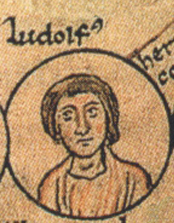
Liudolf of Lotharingia, also Ludolf, was Count of Zutphen and Waldenburg.

Herman II, a member of the Ezzonid dynasty, was Archbishop of Cologne from 1036 until his death. According to historian Henryk Zieliński, Hermann was the most influential of the German metropolitans.

The Great Saint Martin Church is a Romanesque Catholic church in Cologne, Germany. Its foundations rest on remnants of a Roman chapel, built on what was then an island in the Rhine. The church was later transformed into a Benedictine monastery. The current buildings, including a soaring crossing tower that is a landmark of Cologne's Old Town, were erected between 1150-1250. The architecture of its eastern end forms a triconch or trefoil plan, consisting of three apses around the crossing, similar to that at St. Maria im Kapitol. The church was badly damaged in World War II; restoration work was completed in 1985.

The House of Limburg-Stirum, which adopted its name in the 12th century from the immediate county of Limburg an der Lenne in what is now Germany, is one of the oldest families in Europe. It is the eldest and only surviving branch of the House of Berg, which was among the most powerful dynasties in the region of the lower Rhine during the Middle Ages. Some historians link them to an even older dynasty, the Ezzonen, going back to the 9th century.
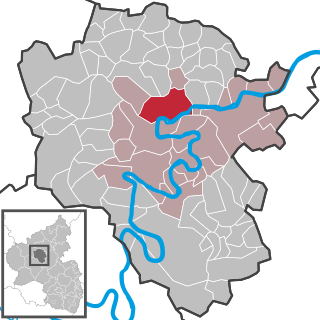
Klotten is an Ortsgemeinde – a municipality belonging to a Verbandsgemeinde, a kind of collective municipality – in the Cochem-Zell district in Rhineland-Palatinate, Germany. It belongs to the Verbandsgemeinde of Cochem, whose seat is in the like-named town. It is a winemaking centre.
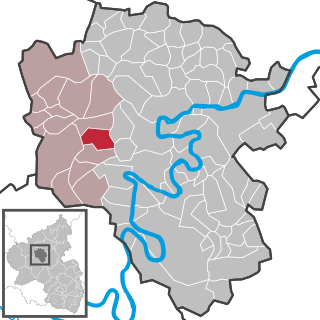
Weiler is an Ortsgemeinde – a municipality belonging to a Verbandsgemeinde, a kind of collective municipality – in the Cochem-Zell district in Rhineland-Palatinate, Germany. It belongs to the Verbandsgemeinde of Ulmen, whose seat is in the like-named town. Weiler is also a recognized tourism municipality (Fremdenverkehrsgemeinde).
Wolfhelm of Brauweiler was the Benedictine abbot of Brauweiler Abbey, near Cologne, Germany.
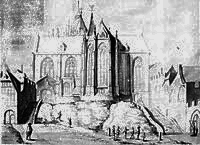
St. Maria ad Gradus is the name of a former church located East of the Cathedral of Cologne, Germany, situated between the cathedral and the Rhine.
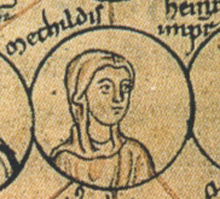
Matilda, Countess Palatine of Lotharingia, was a member of the Ottonian dynasty.

Mathilde was Abbess of Essen Abbey from 973 to her death. She was one of the most important abbesses in the history of Essen. She was responsible for the abbey, for its buildings, its precious relics, liturgical vessels and manuscripts, its political contacts, and for commissioning translations and overseeing education. In the unreliable list of Essen Abbesses from 1672, she is listed as the second Abbess Mathilde and as a result, she is sometimes called "Mathilde II" to distinguish her from the earlier abbess of the same name, who is meant to have governed Essen Abbey from 907 to 910 but whose existence is disputed.

The Altenberger Dom is the former abbey church of Altenberg Abbey which was built from 1259 in Gothic style by Cistercians. Listed as a cultural heritage, it is located in Altenberg, now part of Odenthal in the Rheinisch-Bergischer Kreis, North Rhine-Westphalia, Germany. Until 1511, the church was the burial site of counts and dukes of Berg and the dukes of Jülich-Berg.

Marienstatt Abbey is a Cistercian monastery and a pilgrimage site in Streithausen, Westerwaldkreis, Rhineland-Palatinate, in the Nister valley near Hachenburg.

Ida was abbess of the convent St. Maria im Kapitol in Cologne. She belonged to the family of the Ezzonids, who became prominent in Lower Lorraine in the 11th century.















